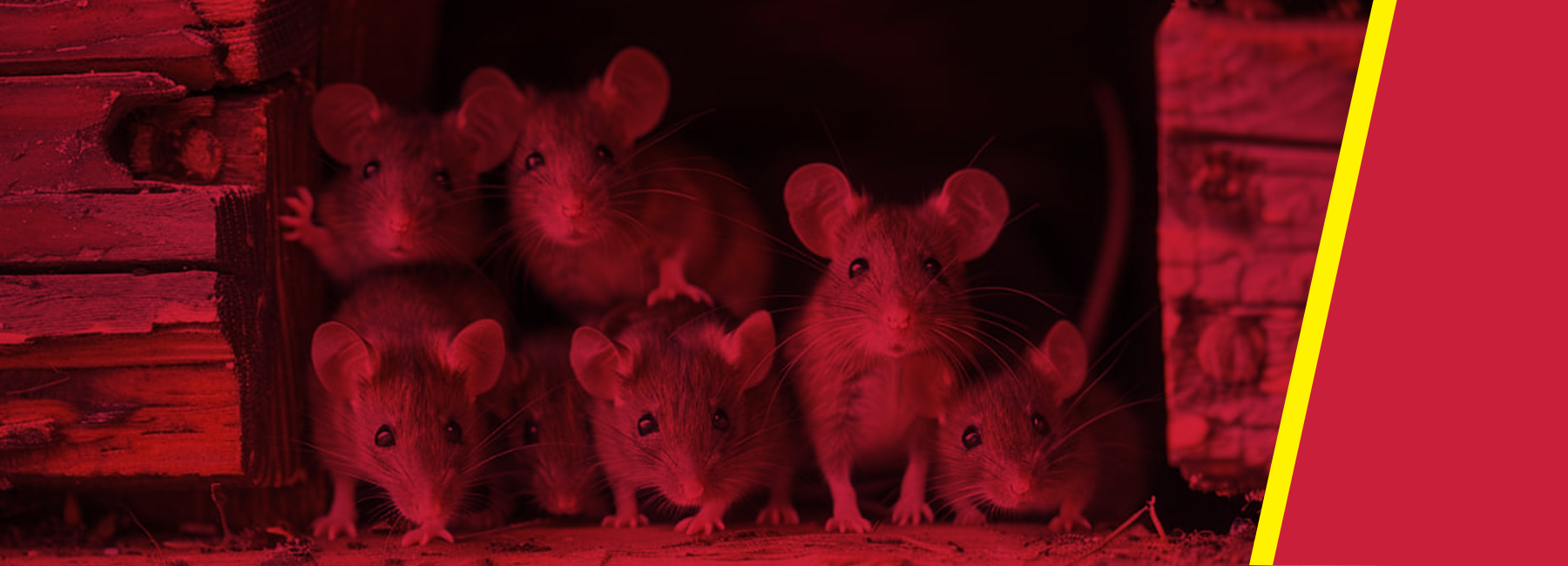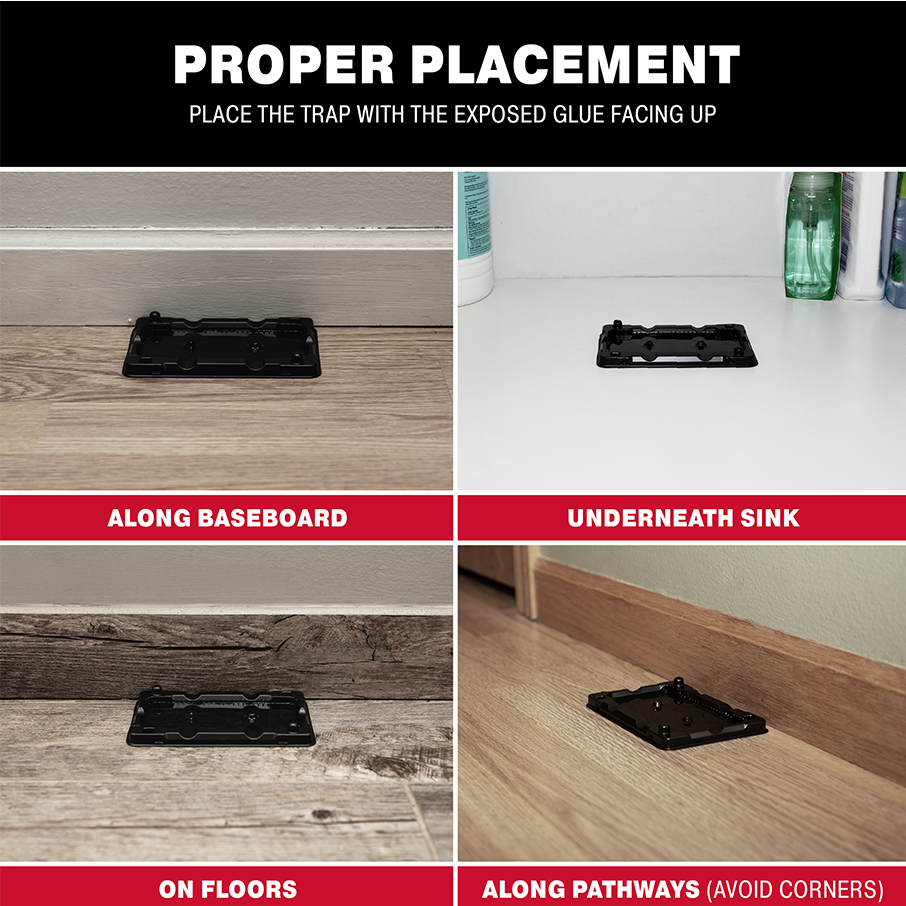
How to Use Glue Traps for Mice in Your Basement.
Catchmaster - The Ultimate in Mouse-Stopping Power.

How to Use Glue Traps for Mice in Your Basement.
Mice are more than just a nuisance—they invade your home through the tiniest openings, contaminate your food, nest in your linens, and leave behind droppings, hair, and other unpleasant signs of their presence. These pests are a real threat to your family’s health and comfort. Thankfully, Catchmaster has over 70 years of expertise in crafting glue traps with our professional-grade, 100% non-toxic glue formula. Our traps don’t just stop mice—they stop all the problems that come with them.
Catchmaster - The Ultimate in Mouse-Stopping Power.
Mice are more than just a nuisance—they invade your home through the tiniest openings, contaminate your food, nest in your linens, and leave behind droppings, hair, and other unpleasant signs of their presence. These pests are a real threat to your family’s health and comfort. Thankfully, Catchmaster has over 70 years of expertise in crafting glue traps with our professional-grade, 100% non-toxic glue formula. Our traps don’t just stop mice—they stop all the problems that come with them.
What Do the Most Common Mice Look Like?
The most common culprits include the House Mouse (Mus musculus), Deer Mouse (Peromyscus maniculatus), White-Footed Mouse (Peromyscus leucopus), and Field Mouse (Apodemus spp.). Catchmaster’s proven solutions ensure that no matter which mice are causing trouble, you can take back control of your home.
-
House Mouse
- Appearance: Small, brownish gray with a lighter belly, about 2.5-4 inches long (excluding tail).
- Behavior: Excellent climbers and jumpers, they live near food sources and are active year-round.
- Habitat: Found in walls, attics, basements, and kitchens.
- Concerns:Known carriers of diseases, they contaminate food and can cause structural damage with their gnawing.
-
Deer Mouse
- Appearance: Brown with white underbelly and feet; larger eyes and ears than house mice.
- Behavior: Nocturnal and less likely to enter urban areas but may invade rural homes, garages, and sheds.
- Habitat: Prefers wooded areas but will enter homes in colder months.
- Concerns: Can carry Hantavirus, which is dangerous to humans.
-
White-Footed Mouse
- Appearance: Similar to deer mouse but slightly larger and with white feet.
- Behavior: They seek shelter in homes during winter and can be active all year.
- Habitat: Typically found in rural or suburban areas, nesting in woodpiles, garages, and attics.
- Concerns: Known carriers of Lyme disease through ticks they may transport.
Mice Love Basements
Nearly every basement has unfinished storage spaces filled with food and linens—prime targets for mice. These unwelcome guests feast on your food, nest in your linens, and leave behind urine, feces, saliva, and hair, all of which are common carriers of disease. Worse yet, mice often bring ticks and fleas into your home, which can be hard to spot but cause serious issues. Ticks can transmit Lyme disease, while fleas can trigger major infestations that threaten your pets and family.
In a basement infestation, pathogens and parasites often have nowhere to go, allowing the problem to worsen before you even notice it. Fortunately, Catchmaster’s glue traps for mice are proven to tackle these issues head-on. Our professional-grade glue is specially formulated to capture not only mice but also the bacteria, viruses, and parasites they carry, offering 360 degree protection. Whether your basement is dusty, dry, or damp, Catchmaster has you covered with glue boards designed for every environment, including heavy-duty trays for challenging conditions. Take back your basement with tools trusted for over 70 years.
Signs of Mice in Your Basement
The Solution: Glue Traps - Glue Boards & Trays

Glue Boards - The Multi-Purpose Solution
Using glue traps for mice effectively begins with choosing the right trap. Catchmaster’s glue boards are a versatile option, designed to meet various needs. They can be laid flat in clean, dust-free areas or folded into protective tunnels to shield the glue surface from dust, which can weaken its effectiveness. However, it’s important to note that the cardboard base isn’t suitable for damp or wet conditions, as moisture can cause it to degrade and render the trap ineffective. For damp areas, consider our heavy-duty glue trays, built to handle challenging environments.
Using glue boards effectively follows the same process for all types. Start by removing the glue boards from their packaging and placing them along the walls of your basement—but don’t remove the adhesive cover yet. Mice are naturally cautious about new objects in their environment. By leaving the glue boards with their covers on for 3-5 days, you allow the mice time to acclimate to their presence.
Avoid placing glue boards in corners. Mice tend to steer clear of tight spaces where they feel trapped, and corners are less likely to see activity. Additionally, corners often collect dust and dirt, which can compromise the glue’s effectiveness, even if the board is folded into a tunnel. Instead, position the glue boards every four to six feet along the base of the walls, ensuring they are at least four feet away from corners.
After the acclimation period, peel off the adhesive cover and place the oards back in their original positions on the floor. Check the boards every other day, and replace them when they’ve caught a mouse or if the glue becomes compromised. With Catchmaster’s glue traps, you can tackle mouse problems with ease and efficiency.
The type of glue board you need depends on the type of mouse, as Catchmaster makes a series of glue boards with different levels of mouse-stopping power at different price points.
-
Buy MaxCatch Glue Boards
The MaxCatch Sticky Glue Mouse Traps – great for insects and smaller mice like deer and house mice
-
Buy Glouee Louee Glue Boards
The Glouee Louee – Our Strongest-Hold Glue Board. Effective against all types of mice & some rats too.

Glue Trays – The Most Powerful Glue Traps for Mice
For the ultimate in mouse-stopping power, choose Catchmaster’s glue trays when dealing with damp areas or if you're unsure of the best option. Built with thick, heavy-duty plastic trays and layered with our legendary, professional-grade glue, these traps provide the strongest hold in our lineup. Perfect for challenging environments, they excel near water sources like basement drains or sweating pipes where mice are likely to frequent. Their high-capacity design makes them ideal for handling more serious mouse infestations, offering reliability and efficiency when you need it most. With Catchmaster, you can confidently tackle even the toughest mouse problems.

Deploying Glue Trays is a Straight Forward Process.
It's just like using glue boards, but with one key difference: there is no adhesive cover to remove. The trays are shipped folded together, and once you separate them, they are immediately ready for use and should be placed right away.
Follow the same placement recommendations as glue boards avoid corners and position the trays every four to six feet along walls where mice are active. Check them regularly and replace when full to maintain their effectiveness. With Catchmaster’s glue trays, you’ll have a powerful and ready-to-use solution for tackling mouse infestations.
As long as the space you are trying to stop mice in remains largely dust-free, you can’t go wrong with glue trays as your weapon of choice. All are effective against the four most common types of mice.
-
Buy Rat, Mouse & Insect Glue Trays
Rat, Mouse & Insect Glue Trays – high catch capacity, great mouse-stopping power, and great for all insects and mice
-
Buy Mouse & Insect Glue Trays
Mouse & Insect Glue Trays – Lower capacity, more discrete, same great mouse-stopping power, and great for all insects and mice

Disposal
Disposing of glue traps is simple but requires proper precautions to ensure safety. Before handling a glue trap with a captured mouse, be sure to wear long sleeves, long pants, surgical gloves, a surgical mask, and eye protection. While Catchmaster’s glue boards and trays are proven to securely trap pathogens, parasites, excretions, fur, and the mouse itself, we strongly recommend taking every precaution to protect yourself during disposal. Your safety is always our priority.
Once you’ve equipped yourself with proper protective gear, grab a gallon-sized freezer bag for disposal. Carefully approach the trap and pick it up without touching the glue surface. Place the used trap inside the freezer bag, seal it securely, and repeat this process for each spent trap in your basement. Afterward, remove your protective gear, place it in a separate bag, and dispose of it in an outdoor trash receptacle that’s safely away from people and pets. Replace spent traps to ensure on-going treatment or monitoring and keep your home protected.
Conclusion
Mice are more than just a nuisance they cause damage and carry illnesses and diseases. With the mouse-stopping power of Catchmaster’s glue boards and glue trays, you can eliminate not only the mice but also the secondary threats they bring, such as pathogens and parasites. Every trap is crafted with our legendary, 100% non-toxic glue formula, trusted by professionals for over 70 years.
Our glue boards are perfect for dusty, dry areas, while our glue trays excel in wet or damp environments—or if you’re unsure which option is best. Need help? Catchmaster’s unique chat functionality on our website connects you directly with an expert, ready to guide you on your journey to become a true Catch Master!
Key Takeaways
- House, Deer, White-Footed, and Field Mice are the most common varieties of mice found in homes around the USA
- Mice love basements – they are warm, safe, and usually have food, water, and places for making nests.
- Droppings, mouse fur, odors/stains in insulation, gnaw marks, nests, smudges on baseboards, or holes/burrows are all signs of a mouse infestation
- Glue boards are great for dusty, dry places; glue trays are better for damp conditions or if you aren’t sure exactly which trap is right for you
- Always wear personal protective equipment when disposing of spent traps and be sure to replace them so you can monitor for mouse problems and stop them before they start
Thanks for reading - you’ve taken
your first steps toward becoming a Catchmaster! Use code MOUSESTOPPINGPOWER at
checkout to save 15% on MaxCatch & Glouee Louee glue boards and glue trays.


















